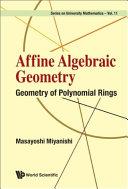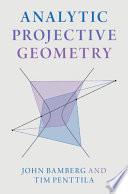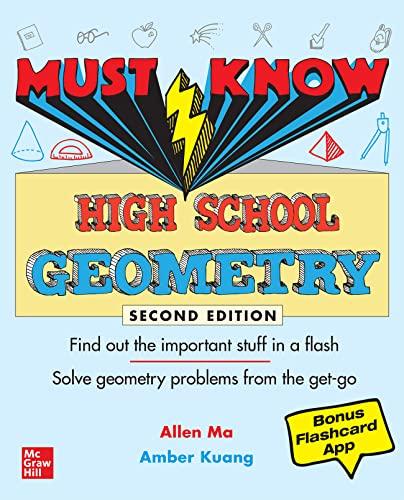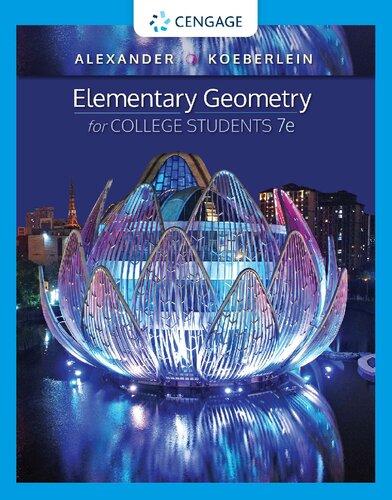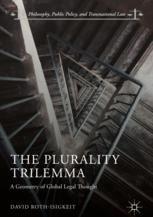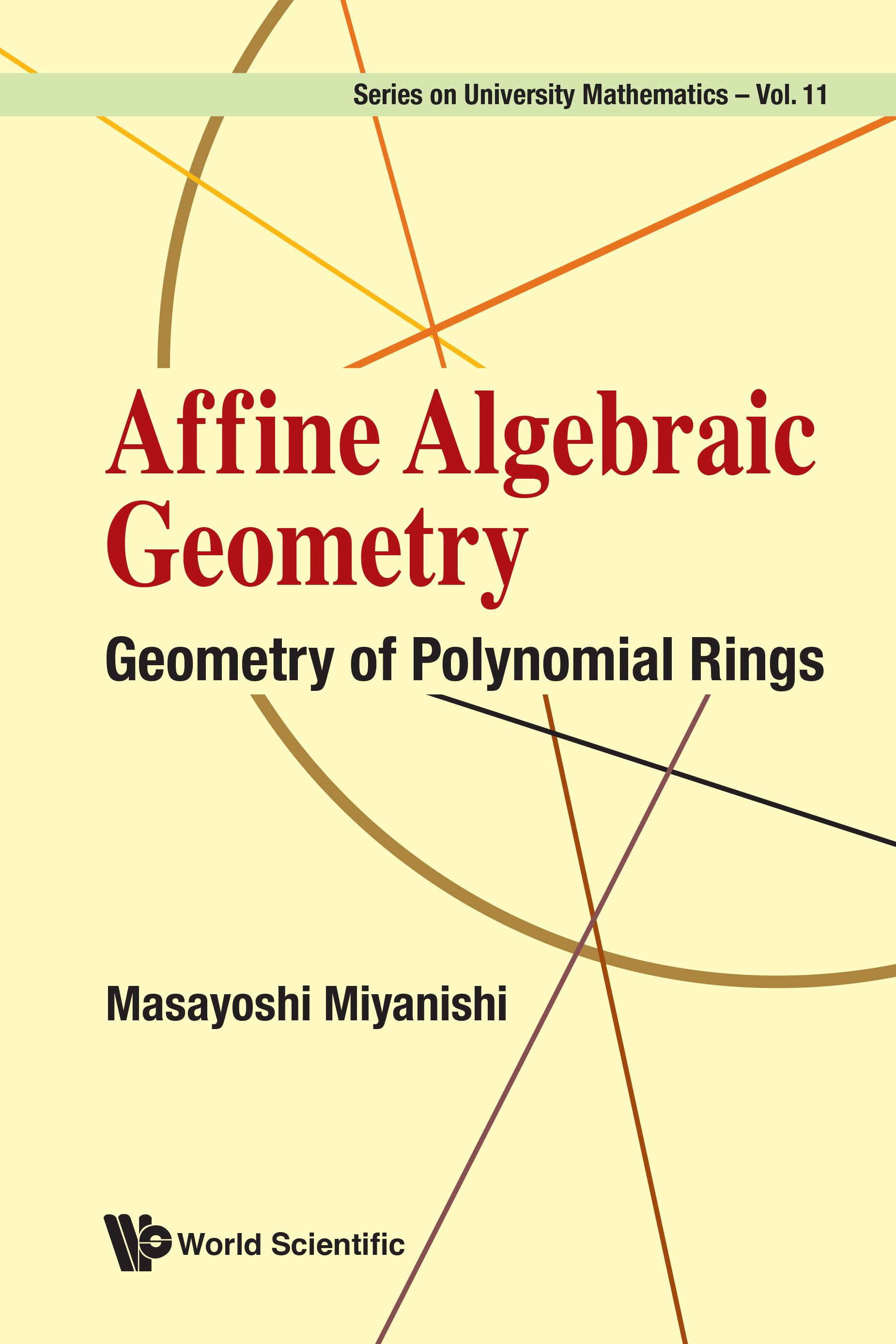TothelateProfessorMasayoshiNagata
This page intentionally left blank
Preface
OneoftheinnovationsbroughtintoalgebraicgeometrybyA.Grothendieck throughhispublicationsincluding ´ El´ementsdeG´eom´etrieAlg´ebrique is theestablishmentofabijectivecorrespondencebetweenaffineschemesand commutativerings,bywhichonecanintroducealgebro-geometricmethodstocommutativealgebraandcreateviceversaanewfieldinalgebraic geometrywhereonestudiesgeometryofaffinedomainsoverafield.
Anaffinedomain A overafield k isthequotientringofapolynomialring k[x1,...,xn]byanideal I.Ageometricapproachtostudyanaffinevariety X =Spec A withcoordinatering A isconsideredtostudygeometricallya big ringlike A whichisnotafiniteunionoflocalrings.1
StudyofpolynomialringshasbeenanimportantsubjectinMathematics,andtherearevariousapproachesdependingonwhichareaofMathematicspolynomialsorpolynomialringsareconsideredin.Franklyspeaking, whatisdecisivelyunderstoodaboutpolynomialsinalgebraicgeometryis limitedtothecaseofonevariable.Manypartialresultsareobtainedinthe caseofmanyvariables,butcomprehensiveunderstandingisnotdecisive.
Duringthesameperiod,butawayfrominfluencesofA.Grothendieck, mathematiciansincludingM.Nagata,Sh.Abhyankar,T.T.Moh,M.Suzuki andothershavestartedtheirownstudyofpolynomialsintwovariablesover thecomplexnumberfield C throughpreciseanalysisofhowtheaffineplane curvedefinedbyapolynomialbehavesatinfinity,i.e.,outoftheaffineplane. Theircontributionculminatedin Abhyankar-Moh-Suzukitheorem,which statesthatapolynomial f (x,y)whosezerolocus {f =0} isisomorphicto anaffinelinecanbetakenasoneofcoordinates,i.e., C[x,y]= C[f,g]for somepolynomial g(x,y).Thisresultrevivedinterestintheautomorphism
1Wewouldliketocallthem globalrings iftherearenofearofmisunderstandings.
theoremof C[x,y]byJung-VanderKulkandgeometricproblemsonaffine surfacesincludingthe CancellationProblem. 2 Thishappenedfromthelate 1960stotheearly1970s.
AroundthesameperiodtherewasalsoaworldwiderevivalofinteresttowardtheEnriques-Kodairaclassificationofalgebraicsurfaces.In themid-1970s,S.Iitakaintroducedthe logarithmicKodairadimension of noncompletealgebraicvarietiesandproposedaprojectofclassifyingnoncompletesurfaceswithexpectationsthatlogarithmicKodairadimension shouldworkasKodairadimensiondidintheclassificationofsmoothprojectivesurfaces.Iitaka’sstudentsincludingS.TsunodaandY.Kawamata, andthepeopleincludingT.FujitaandtheauthorshowedthatIitaka’sexpectationdidworktoacertaindegreeandbringsomeresultsbeyondthe expectation.3 Theirapproachisnowdevelopedinto logarithmicgeometry, whichisastudyofpairs(V,D)ofacompletevariety V andaneffective divisor D.Inmostcases,byHironaka’sresolutionofsingularities, V is madetobesmoothand D adivisorwithsimplenormalcrossings.The studysofarshowsthatgeometrychangesaccordingtowhatkindofsingularitiesisadmittedon V and D.Foranaffinevariety X,wefindeasilysuch apair(V,D)byembedding X intoaprojectivespaceviatheembedding X → An → Pn andtakingtheclosure X as V and D = V \ X.Bythis approach,oneisabletoobservethegeometricbehaviorof X atinfinity, i.e.,on D ornear D 4
Thereisthefamous JacobianConjecture whichassertsthatifpolynomials f1,...,fn ∈ C[x1,...,xn]haveanonzeroconstantastheJacobian determinant
∂(f1,...,fn)
∂(x1,...,xn) then C[x1,...,xn]= C[f1,...,fn].Underthisassumption,themapping
φ : An → An , (x1,...,xn) → (f1,...,fn) inducesalocalanalyticisomorphismbetweeneverypointoftheorigin An anditsimageofthetarget An.So,theconjectureasksiftheselocalanalytic isomorphismsareinducedbyapolynomialisomorphism.Unfortunately,
2Itisalsocalledthe Zariski’sProblem
3Seetheauthor’sbookon Openalgebraicsurfaces [59].
4Thisapproachwasandhopefullystillissuccessfulasexemplifiedbyasolutiondueto M.KorasandK.Palkaofthelong-standingCoolidge-Nagataconjecturewhichasserts thatacomplexirreduciblecurveon P2 homeomorphictoaline P1 ismappedtoaline byabirationalautomorphismof P2 (see[47]).
theconjectureisnotverifiedeveninthecase n =2.Aformal(oranalytic) inversemappingof φ israthereasytoconstruct,butitisverydifficultto showthattheinversemappingisapolynomialmapping.Thisispartlydue tothefactthattotal(orwhatever)degreeofpolynomialsarenotreliable asameasuretocontrolthebehaviorofpolynomialsbecausethedegree changeseasilyasthesetofcoordinates {x1,...,xn} isreplacedbyanother onehavingchangesofnonlinearterms.Itisnotclearifthereexistsa geometricapproachwhichenablestoreplacethismethodofformalinverse mapping,thoughsomesuccessisobtainedbysuchapproaches.Onehonest impressiontheauthorhadthroughvariousgeometricchallengesisthatthe affinespace(eventheaffineplane)issoimmaculatethatonecannotfind cluestogetageometricstudystartedwith.
Affinealgebraicgeometryemergedfromthesebackgroundsandproblems.Thesubjectswetreatthereinareprobablymorebiasedontheaffine spacesandpolynomialrings,butnothingmorethannoncompletevarieties treatedinstandardalgebraicgeometry.Aslongaswewanttousegeometric approachwecannotavoidaminimumbackgroundofalgebraicgeometry. Hencethisvolumebeginswithanintroductiontoalgebraicgeometry.
Thepresentauthortriedtostartexplanationsfromthebeginningwithoutomissionofproofssothatthereaderswithknowledgeofalgebraand geometrytaughtatthethirdyearleveloftheundergraduatestudycan understand,thoughsomeimportantresultsarenotgivenproofswhichare mostlyinvolvedandtheauthorexpectsareprovidedbymoreadvanced textbookswithestablishedreputation.Precisereferencesaregivenwith fewexceptionsinsuchcases.
ThefirstchapterofthepresentvolumeisbasedonthelecturesonalgebraicgeometrywhichtheauthorgaveatKwanseiGakuinUniversityfor graduatecoursesoverseveralyears.Somepartsaretakenfromtheauthor’sbooksonhigheralgebraandalgebraicgeometrywhicharewritten inJapaneseandhaveneverbeentranslatedintoforeignlanguages[60, 78]. Onecanconsiderthefirstchapterasaquickintroductiontoalgebraicgeometryandcommutativealgebra,andskipitifonehassomebackgroundon thesubject.Enriques-Kodairaclassificationofprojectivealgebraicsurfaces aswellasthetheoryoflogarithmicKodairadimensionisexplainedin[59], althoughthereferredbookisanadvancedoneforspecialistsandgraduate students(perhapsPh.Dstudents).Weareremindedtomakethisvolume asaccessibleaspossibleforthebeginningstudentsinalgebraicgeometry. So,wetriednottomakeheavyuseofadvancedresults.
TopicsspecializedinaffinealgebraicgeometrybeginfromChapter2
onward.ThefirsttopicisaproofoftheAMStheoremwhichusesthe linearpencilofcurvesontheprojectiveplane P2 andtheeliminationof basepoints.Infact,theseresultssymbolizethedawnofaffinealgebraic geometry.WethenexplaingeneralizationsoftheJacobianconjectureindimensiontwo.Thereaderswillseehoweffectivelyaffinealgebraicgeometry isusedtothisconjecture.Thereisalsoawishoftheauthortorevealcontributionsofhiddenramificationattheinfinityto(notnecessarily)finite ´etalecoveringsofnoncompletevarieties.
Thepresentationofsection1.4,subsections1.8.4and1.8.5isbasedon thecontentsof[78].Theauthorwouldliketoexpresshisbelatedthanks tolateProfessorsMasayoshiNagataandMasakiMaruyamaforthejoint authorshipofthebook.ThepresentbookisdedicatedtoProfessorNagata, whoisoneofthefoundersoftheresearchareaofstudyinggeometryof rationalsurfacesandpolynomials.ThecontentsofChapters2and3are partlybasedontheauthor’slecturenotes[58]and[62].Lastbutnot theleast,theauthorwouldliketoexpresshisindebtednesstotheeditor Ms.KwongLaiFunofWorldScientificPubl.Co.fortheopportunityto writeabookonaffinealgebraicgeometryandconstantencouragement duringthewritingofthisbook.
June,2023
M.Miyanishi
1.1Reviewonbasicresultsincommutativealgebra...... 1
1.1.1Ringofquotientsandlocalring.......... 1
1.1.2SpectrumofaringandZariskitopology...... 3
1.1.3Irreducibledecompositionofatopologicalspace. 5
1.1.4Primeidealdecompositionofradicalideals.... 7
1.1.5Genericpoint,closedpointandKrulldimension. 9
1.1.6Hilbertbasistheorem................ 11
1.1.7IntegralextensionandNoethernormalizationlemma 12
1.1.8Lying-overtheoremandGoing-uptheorem.... 16
1.1.9Krulldimensionofaffinedomains......... 19
1.2Reviewonfinitelygeneratedfieldextensions........ 20
1.2.1Transcendencebasisandtranscendencedegree.. 20
1.2.2Regularextensionandseparableextension.... 24
1.3Schemesandvarieties.................... 27
1.3.1Affineschemesoffinitetypeandaffinevarieties. 27
1.3.1.1Irreducibledecompositionofanaffine schemeoffinitetype........... 27
1.3.1.2Densityofthesetofclosedpoints.... 28
1.3.1.3Affinevarietiesandfunctionfields.... 30
1.3.1.4Structuresheaves............. 31
1.3.2Morphismsofaffineschemes............ 33
1.3.2.1Intersectionofaffineopensets......
1.3.2.2Openimmersionandclosedimmersion. 35
1.3.2.3Behaviorofstructuresheavesundera morphism.................
1.3.3.1Definitionandexamplesofschemes...
1.3.3.3Fiberproductsofschemes........
1.3.3.4Separatedschemes............
1.3.3.5Rationalmapsofalgebraicvarieties...
1.4.1Gradedringsandprojectivespectrums......
1.4.2.2Projectivevarieties............
1.4.2.3Projectiveclosureofanaffinevariety..
1.5Normalvarieties.......................
1.5.1Discretevaluationringsandnormalrings.....
1.5.2Normalizationofaffinedomains..........
1.5.4Uniquefactorizationdomains............
1.5.5Weildivisorsanddivisorclassgroup........
1.6.1Systemofparametersandregularlocalring....
1.6.2Regularsequenceanddepthofalocalring....
1.6.4Sheafofdifferential1-formsandcanonicalsheaf.
1.7.2Cartierdivisors....................
1.7.3Linearsystems....................
1.7.4 D-dimension,Kodairadimensionandlogarithmic Kodairadimension..................
1.8Algebraiccurvesandsurfaces................
1.8.1SerredualityandEuler-Poincar´echaracteristic..
1.8.3Algebraiccurves...................
1.8.4Intersectiontheoryonalgebraicsurfaces......
1.8.5Riemann-Rochtheoremforsurfaces........
1.8.6Fibrationsandrelativelyminimalmodelsof
1.9.3Inductivelimitsandprojectivelimits.......
1.9.3.1Inductivelimits..............
Cechcohomologyofsheavesofabeliangroups..
1.9.6.2Coherentsheafcohomologiesover
2.2.1Euclideantransformationassociatedwith admissibledata...................
2.2.2(e,i)-transformationassociatedwithadmissible data..........................
2.2.3Irreducibleaffinecurveswithone-placeatinfinity
2.2.4Abhyankar-Moh-Suzukitheorem..........
2.2.5TheoremofGutwirthandpathological
2.3.1Linearpencilsofrationalcurvesandfield generators......................
2.3.2ProofofautomorphismtheorembyJungandvan derKulk.......................
2.4Algebraicgroupactionsontheaffineplane.........
2.4.1Algebraicgroups,actionsandquotientspaces..
2.4.2FinitesubgroupsofAut k[x,y]...........
2.4.3Finitegroupactionsandinvariants........
2.4.4Quotientsingularitiesonsurfaces.........
2.5Birationalautomorphismsofrationalsurfaces.......
2.5.1Noetherfactorizationtheorem...........
2.6Boundarydivisorsofaffinesurfaces.............
2.6.1QuantitativecriterionofSNCdivisors.......
2.6.2Shifttransformationontheboundarydivisor...
2.6.3TheoremofRamanujam-Morrow..........
2.7AppendixtoChapter2....................
2.7.1Unramifiedmorphism................
2.7.2 ´ Etalecoverings....................
2.7.3Riemann-Hurwitzformulaforcurves........
2.7.4Inverseanddirectimagesofdivisorsandthe projectionformula..................
2.7.5Amalgamatedproductoftwogroups........
2.7.6Quotientvarietiesbyfinitegroupactionsand ramificationofthequotientmorphism.......
2.8ProblemstoChapter2....................
3.GeometryandTopologyofPolynomialRings—
3.1Plane-likeaffinesurfaces...................
3.1.1Simplyconnectedalgebraicvarieties........
3.1.2Unitgroup,unitrankandindependenceof boundarydivisors..................
3.1.3Gizatullinsurfacesandaffinepseudo-planes....
3.1.4Affinepseudo-planes—moreproperties......
3.1.5tomDieckconstructionofaffinepseudo-planes..
3.1.6Platonic A1 ∗-fiberspaces...............
3.1.7Homologyplanes...................
3.2Jacobianconjectureandrelatedresults...........
3.2.1Jacobianconjectureanditsvariants........
3.2.2Partialaffirmativeanswers.............
3.3GeneralizedJacobianconjecture—affirmativecases...
3.3.1Resultsinarbitrarydimension...........
3.3.2Resultsforsurfaces.................
3.3.2.1Surfaceshaving A1-fibrations......
3.4GeneralizedJacobianconjectureforvariouscases.....
3.4.1Caseof Q-homologyplanesof κ
3.4.2Counterexamples...................
3.5AppendixtoChapter3....................
3.5.1Makar-Limanovinvariant..............
3.5.2Thefundamentalgroupatinfinity.........
3.5.3AlgebraicsurfacesandlogKodairadimension..
3.5.4Logarithmicramificationformula..........
4.3Cancellationproblems....................
This page intentionally left blank
IntroductiontoAlgebraicGeometry
1.1Reviewonbasicresultsincommutativealgebra
Allringstreatedinthisbookarecommutativeandunitaryunlessotherwise specified.
1.1.1 Ringofquotientsandlocalring
Aring R is noetherian ifeveryascendingchainofideals
I0 ⊆ I1 ⊆···⊆ In ⊆ In+1 ⊆···
ceasestoincrease.Namely,thereexistsaninteger N suchthat In = In+1 forevery n ≥ N .Thisconditioniscalledthe ascendingchainconditionfor ideals (ACC,forshort).TheACCisequivalenttotheconditionthatevery idealisfinitelygenerated.
An R-module M issaidtobe finitelygenerated over R,orsimplya finite R-moduleif M = Rm1 + ··· + Rmn forafinitesetofgenerators {m1,...,mn}.Thequotientmodule M/N ofafinite R-module M byan R-submodule N isafinite R-module,andasubmodule N isalsofiniteif R isnoetherian(seeLemma 1.1.11).Conversely,ifan R-submodule N of M andthequotientmodule M/N arefinite,thensoisthe R-module M . Asubset S ofaring R isa multiplicativeset (ora multiplicativelyclosed set)if
(i) 0 ̸∈ S, 1 ∈ S,and (ii) s,t ∈ S implies st ∈ S
If p isaprimeidealof R,thenthecomplement S := R \p isamultiplicative set.Infact,thedefinitionofprimeidealimplies,bycontrapositive, ab ̸∈ p if a ̸∈ p and b ̸∈ p.If S isamultiplicativesetof R,the ringofquotients
(or ringoffractions) S 1R isdefinedastheset
S 1R = a s | a ∈ R,s ∈ S , where a/s denotestheequivalenceclassintheproduct R × S underthe equivalencerelation
(a,s) ∼ (b,t)ifandonlyif u(at bs)=0forsome u ∈ S.
Hence a/s isconsideredasausualfractionwhosenumeratorisanarbitrary element a ∈ R andwhosedenominatorisanelement s ∈ S.But a/s = b/t if(a,s) ∼ (b,t).If R isanintegraldomain,theaboveequivalencerelation holdsifandonlyif at = bs.Theset S 1R hasaringstructureforwhich additionandmultiplicationaredefinedrespectivelyby
Thereisanaturalringhomomorphism i : R → S 1R definedby i(a)= a/1.
Thekernelof i isanideal
I0 = {a ∈ R | as =0forsome s ∈ S}.
Withthisringhomomorphism i,thereisabijectivecorrespondencebetween theideals I of R suchthat I ⊇ I0 and I ∩ S = ∅ andthesetofidealsof S 1R.Hereweconsideronly proper ideals,where I isa proper idealof R if I ⫋ R.Thebijectivecorrespondenceisgivenby
I → I(S 1R)= a s | a ∈ I,s ∈ S ,J → i 1(J).
Thiscorrespondencerestrictstoabijectionbetween
{p | aprimeidealof R suchthat p ∩ S = ∅} and
{P | aprimeidealof S 1R}.
Wedenotetheideal i 1(J)by J ∩ R byabuseofnotation.Thisobservation impliesthat S 1R isnoetherianifsois R
Forexample,let S = R \ p foraprimeideal p of R.Wedenote(S 1R) by Rp and p(S 1R)by pRp.Then pRp isthebiggestprimeidealwith respecttoinclusion.Hence pRp isaunique maximal ideal1 of Rp.Aring R iscalleda localring ifitcontainsauniquemaximalideal m inthesense thatanyproperideal I of R iscontainedin m.Bythenotation(R, m)we
1Anideal m of R isa maximal idealif I isaproperidealof R suchthat I ⊇ m then I = m
meanthat R isalocalringwithmaximalideal m.Amaximalideal m is aprimeideal.Infact,supposethat ab ∈ m.Let I = m + aR,whichisan idealsuchthat I ⊇ m.Henceeither I = R or I = m.If I = m then a ∈ m. Supposethat I = R.Then1= ax + z with z ∈ m.Then b = abx + bz ∈ m. So, a ∈ m or b ∈ m.
Let R beanintegraldomain.Then S := R \{0} isamultiplicative set.Theringofquotients S 1R isnowafield,whichwecallthe fieldof quotients orthe fieldoffractions anddenoteby Q(R).
Let I beanidealof R.Anidealofthequotientring(ortheresidue ring) R = R/I iswritteninaform J/I,where J isanidealof R suchthat J ⊇ I.If R isnoetherian,soisthering R.
1.1.2 SpectrumofaringandZariskitopology
Let R bearing.Thesetofprimeidealsof R iscalledthe spectrum (spec, forshort)of R anddenotedby
Spec R = {p | aprimeidealof R}
Givenaring R,thespectrumSpec R isalsocalledan affinescheme with the coordinatering R.Wecandefineatopology,calledthe Zariskitopology, inSpec R byassigningclosedsetssatisfyingaxiomsoftopology.Aclosed setis V (I)foranideal I of R,where
V (I)= {p ∈ Spec R | p ⊇ I}.
Axiomsoftopologyforclosedsetsrequire
(i) Spec R and ∅ areclosedsets.
(ii) λ∈Λ V (Iλ)isaclosedset,where {Iλ | λ ∈ Λ} ispossiblyaninfinite set.
(iii) Afiniteunion j∈J V (Ij )isaclosedset.
For(i),wehaveSpec R = V ((0))and ∅ = V (R),where(0)isthezero ideal.For(ii),wehave λ∈Λ V (Iλ)= V ( λ∈Λ Iλ).For(iii),itsufficesto showthat
V (I1) ∪ V (I2)= V (I1I2)= V (I1 ∩ I2), where I1I2 istheidealof R generatedby {a1a2 | a1 ∈ I1,a2 ∈ I2}.Since I1 ∩ I2 ⊇ I1I2 andsince p ⊇ I1I2 implieseither p ⊇ I1 or p ⊇ I2,wehave V (I1) ∪ V (I2) ⊇ V (I1I2) ⊇ V (I1 ∩ I2) ⊇ V (I1) ∪ V (I2), whichprovestheassertion.TheZariskitopologyis T0,butnotnecessarily T1.Namely,iftwodistinctprimeideals p, q aregiven,thereisaclosedset
V (I)whichcontainseitheroneof p or q butnottheother.Onecannot choose p or q.Infact, p ⊂ q ifandonlyif p ∈ V (I)alwaysimply q ∈ V (I) foraclosedset V (I).
Foranideal I,definethe radical of I,denotedby √I,by √I = {a ∈ R | an ∈ I forsome n> 0}
Anideal I isa radicalideal if √I = I.Thenwehavethefollowingtheorem.
Theorem1.1.1. Foranideal I of R wehave
√I = p∈V (I) p.
Proof. If p ∈ V (I)then p ⊃ √I,whence p∈V (I) p ⊇ √I.Weshowthe oppositeinclusion.Ifthereexistsanelement s ∈ ( p∈V (I) p) \ √I,then S = {sn | n ≥ 0} isamultiplicativesetof R suchthat S ∩ I = ∅.Hence I(S 1R)isaproperidealof S 1R.ByZorn’slemma(seeCorollary 1.1.4 below)thereexistsamaximalideal M of S 1R suchthat I(S 1R) ⊂ M.
Let m = R ∩ M(= i 1(M)).Then m isaprimeidealof R suchthat m ⊃ I and m ∩ S = ∅.Namely m ∈ V (I)and m ⊃ p∈V (I) p,whence s ∈ m.This contradicts m ∩ S = ∅.
Corollary1.1.2. Forideals I,J of R, V (I)= V (J) ifandonlyif √I = √J.
Proof. ByTheorem 1.1.1, √I = √J followsif V (I)= V (J).Theconverse isclearbecause V (I)= V (√I)and V (J)= V (√J).
Let S beapartiallyorderedset.Itiscalledan inductiveset ifevery totallyorderedsubsethasanupperbound.Thefollowingresultiscalled Zorn’slemma
Lemma1.1.3. Let S beaninductiveset.Then S hasamaximalelement. Thisresultyieldsanimportantresult.
Corollary1.1.4. Let I beaproperidealofaring R.Thenthereexists amaximalideal m suchthat m ⊇ I.Further,amaximalidealisaprime ideal.
Proof. Let S bethesetofproperidealsof R containing I anddefinea partialorderin S bysetting
J1 ≥ J2 ifandonlyif J1 ⊇ J2
Let J1 ≤ J2 ≤···≤ Jn ≤ Jn+1 ≤··· beatotallyorderedsubsetof S.Set J = n≥1 Jn.Then J isaproperidealof R containing I,and J isclearly anupperboundofthetotallyorderedsubset.Hence S isaninductiveset, and S hasamaximalelement m,whichisamaximalidealof R suchthat m ⊇ I.
Let m beamaximalideal.Supposethat ab ∈ m with a,b ∈ R.Then aR + m isanidealcontaining m.Hence aR + m = m or aR + m = R.If aR + m = m then a ∈ m.If aR + m = R then ax + m =1for x ∈ R and m ∈ m.Then b = b(ax + m)= abx + bm ∈ m.So,either a ∈ m or b ∈ m. Thisimpliesthat m isaprimeideal.
1.1.3 Irreducibledecompositionofatopologicalspace
Atopologicalspace X is noetherian ifadescendingchainofclosedsets F1 ⊇ F2 ⊇···⊇ Fn ⊇ Fn+1 ⊇··· stopsalwaystodecrease,i.e.,thereexists N> 0suchthat Fn = Fn+1 for every n ≥ N .If R isanoetherianringthen X =Spec R isanoetherian space.Infact,write Fi = V (Ii)with Ii = √Ii = p∈Fi p.Thenthe descendingchainofthe Fi correspondstoanascendingchainofradical idealsof R
I1 ⊆ I2 ⊆···⊆ In ⊆ In+1 ⊆··· andtheterminationoftheidealchainimpliestheterminationofthechain ofclosedsets.
Atopologicalspace X is quasi-compact ifanyopencovering U = {Uλ}λ∈Λ of X hasafiniteopensub-covering X = U1 ∪ U2 ∪···∪ Un, where Ui = Uλi with λi ∈ Λ.
Lemma1.1.5. Anoetheriantopologicalspaceisquasi-compact.
Proof. Let U = {Uλ}λ∈Λ beanopencoveringof X.Wemayassume thatforany µ ∈ Λ, λ∈Λ\{µ} Uλ = X.Considerawell-orderingonΛand supposethat
λ1 <λ2 < <λn <λn+1 < andidentify λi with i ∈ Z.Let
Fn = X \ (U1 ∪ U2 ∪···∪ Un), whichisaclosedsetof X satisfying
F1 ⊃ F2 ⊃···⊃ Fn ⊃ Fn+1 ⊃···
Since X isnoetherian,thedescendingchainofclosedsetsceases,i.e.,there exists N> 0suchthat Fn = Fn+1 forall n ≥ N .Then FN = ∅.Hence X = U1 ∪ U2 ∪···∪ Un.
Atopologicalspace X is reducible ifthereisadecomposition X = F1∪F2 fortwoclosedsets F1,F2 with Fi ⫋ X.Otherwise, X iscalled irreducible. If F isaclosedsubsetof X,wecansaythat F isreducible(orirreducible) withrespecttotheinducedtopologyon F .
Lemma1.1.6. Let F beaclosedsubsetofanoetheriantopologicalspace X.Thenthereexistsafinitesetofirreducibleclosedsubsets F1,...,Fn suchthat F = F1 ∪ F2
Fn,F
Fj forall i = j. Theseclosedsubsets Fi aredeterminedbythesubset F uniquelyuptopermutations.
Theset Fi iscalledthe irreduciblecomponent of F andthedecomposition F = F1 ∪ F2 ∪···∪ Fn iscalledthe irreducibledecomposition
Proof. Weprovefirsttheexistenceofadecomposition.Let S betheset ofclosedsubsets F of X suchthat F isnotafiniteunionofirreducible closedsubsets.Then S isaninductivesetwithrespecttoanorderdefined byreverseinclusionofsubsets.Namely, F ≤ F ′ for F,F ′ ∈ S if F ′ ⊆ F . Givenan(ascending)totallyorderedsubsetof S,thereexistsanupper boundbythenoetherianconditionof X whichceasesdescendingchains ofclosedsubsetsof X.Hence S hasamaximalelement,say F0.Then F0 isreducible.Write F0 = F1 ∪ F2 forproperclosedsubsets F1,F2 of F0.Then F1 >F0 and F2 >F0.Since F0 isamaximalelementof S, F1 and F2 arewrittenasfiniteunionsofirreducibleclosedsubsets.Writethe decompositionsas
F1 = F11 ∪ F12 ∪···∪ F1r F2 = F21 ∪ F22 ∪···∪ F2s, where Fij isirreduciblefor i =1, 2.Thenwehave
F0 = F1 ∪ F2 =(F11 ∪···∪ F1r) ∪ (F21 ∪···∪ F2s), whichisafiniteunionofirreducibleclosedsubsets.Thiscontradictsthe assumptionthat F0 ∈ S Weprovenextthatadecompositionisuniqueuptopermutations.Let F = G1 ∪ G2 ∪···∪ Gm
beanotherirreducibledecompositionofthesamekindasinthestatement. Thenwehave
G1 = G1 ∩ F =(G1 ∩ F1) ∪ (G1 ∩ F2) ∪···∪ (G1 ∩ Fn)
Since G1 isirreducible, G1 = G1 ∩ Fi forsome1 ≤ i ≤ n.Afterapermutationofindices,wemayassumethat i =1.Then G1 ⊆ F1.Similarly,we have F1 =(F1 ∩ G1) ∪···∪ (F1 ∩ Gm).
Hence F1 = F1 ∩ Gj andhence F1 ⊆ Gj .Thisimpliesthat G1 ⊆ Gj , whence j =1.Namely F1 = G1.Wecanargueasabovebyreplacing F1 by Fj ,andshowthat n = m and Fi = Gi afterasuitablepermutationof indices.
1.1.4 Primeidealdecompositionofradicalideals
Lemma1.1.7. Let R beanoetherianringandlet X =Spec R.Let I be aradicalidealof R andlet F = V (I).If F isirreduciblethen I isaprime ideal.Conversely,if I isaprimeidealthen V (I) isirreducible.
Proof. Supposethat ab ∈ I.Then,forany p ∈ F , ab ∈ I ⊆ p.Hence a ∈ p or b ∈ p.Thisimpliesthat F ⊂ V (a) ∪ V (b),where V (a)= V (aR) and V (b)= V (bR),and F =(F ∩ V (a)) ∪ (F ∩ V (b)), where F ∩ V (a)= V (I + aR)and F ∩ V (b)= V (I + bR).Since F is irreducible, F = F ∩ V (a)or F = F ∩ V (b),i.e., F ⊆ V (a)or F ⊆ V (b). Thisimpliesthat aR ⊆ p∈F p = √I = I, or bR ⊆ I.
Hence a ∈ I or b ∈ I.So, I isaprimeideal. Weprovetheconverse.Supposethat V (I)isreducible,andwrite V (I)= V (I1) ∪ V (I2)with V (I1) ⫋ V (I)and V (I2) ⫋ V (I).Since V (I1) ∪ V (I2)= V (I1I2),itfollowsthat I1I2 ⊆ I.Since I isaprime ideal,either I1 ⊆ I or I2 ⊆ I.Theneither V (I) ⊆ V (I1)of V (I) ⊆ V (I2). Thisisacontradiction.
Corollary1.1.8. Let R beanoetherianringandlet F = V (I) fora radicalideal I.Thenthereexistsauniquelydeterminedsetofprimeideals {p1,..., pn} suchthat
(i) I = p1 ∩ p2 ∩···∩ pn,and (ii) pi ̸⊂ pj foranypair (i,j) with i = j.
Theclosedsubsets V (p1),...,V (pn) correspondbijectivelywithirreducible components F1,...,Fn of F = V (I).
Proof. Thereisanirreducibledecompositionof F whichisuniquelydetermineduptopermutationsofcomponents F = F1 ∪···∪ Fn,
where Fi = V (pi)foraprimeideal pi.Thenwehave V (I)= V (p1) ∪···∪ V (pn)= V (p1 ∩···∩ pn),
where p1 ∩···∩ pn isaradicalideal.ThenitfollowsbyCorollary 1.1.2 that I = p1 ∩···∩ pn.
Thedecomposition
I = p1 ∩ p2 ∩···∩ pn
inCorollary 1.1.8 iscalledthe primedecomposition2 oftheradicalideal I. Forafixed1 ≤ i ≤ n,write j=i
and j=i
where ∨ pi showsthattheideal pi isomitted.Then j=i pj ⊆ j=i pj ,and hence j=i pj ̸⊂ pi because pi ̸⊂ pj foranypair(i,j).Let ai beanelement of( j=i pj ) \ pi.Foranelement a ∈ R,thesubset
(I : a)= {x ∈ R | ax ∈ I}
iscalledan idealquotient oftheideal I.Itisanidealof R containing I Fortheidealquotient(I : ai)itholdsthat(I : ai)= pi.Infact,if x ∈ pi then aix ∈ ( j=i pj )bythechoiceof ai and aix ∈ pi because x ∈ pi.Hence aix ∈ I and pi ⊆ (I : ai).Conversely,if x ∈ (I : ai)then aix ∈ I and
2Laterweneedafinerdecompositionofideals,calledthe primarydecomposition of ideals.Wedevelopthetheoryintheappendix.
ai ̸∈ pi.Hence x ∈ pi.Thisshowsthat pi =(I : ai).Furthermore,ifan idealquotient(I : a)isaprimeideal p,then p ⊇ I ⊇ n i=1 pi.
Hence p containssome pi.Wesaythattheidealquotient(I : a)isa prime divisor of I if(I : a)isaprimeideal.Thesetofallprimedivisorsof I is denotedbyAss(R/I).Theneach pi isa minimal amongprimedivisorsof I withrespecttotheinclusionorder.Anon-minimalprimedivisorof I is called embedded.
Theradical n = √0ofthezeroideal(0)of R iscalledthe nilradical. Let n = √0= p1 ∩ p2 ∩···∩ pn betheprimedecomposition.Sinceanyprimeideal p of R contains n,the aboveargumentshowsthat p ⊇ pi forsome1 ≤ i ≤ n.Thisimpliesthat X =Spec R = V (p1) ∪ V (p2) ∪···∪ V (pn) andeach V (pi)isanirreduciblecomponentof X
1.1.5 Genericpoint,closedpointandKrulldimension
Let R beannoetherianringandlet X =Spec R.Wehaveaprimeideal px identifiedwitheachpoint x ∈ X.Forasubset S of X,wedenoteby S theclosureof S withrespecttotheZariskitopology.Apoint x of X isa closedpoint if {x} = {x}.Apoint x isa genericpoint if X = {x}. Lemma1.1.9. Thefollowingassertionshold.
(1) S = V (I(S)),where I(S)= x∈S px.
(2) If S consistsofasinglepoint x thentheclosure {x} isirreducible.We have {x} = {y} ifandonlyif x = y
(3) x isthegenericpointofanirreduciblecomponentof V (I) ifandonly if px isaminimalprimedivisorof √I (4) X isirreducibleifandonlyifthenilradical √0 of R isaprimeideal. (5) x isaclosedpointifandonlyif px isamaximalideal.
Proof. (1)Ifaclosedset V (I)contains S then px ⊇ I forevery x ∈ S.This impliesthat I ⊆ I(S),where I(S)isa radicalideal,i.e., I(S)= I(S). Thisimpliesthat I(S)definesthesmallestclosedsubsetof X whichcontains S,i.e.,theclosureof S
(2)By(1), {x} = V (px)whichisirreduciblebyLemma 1.1.7.Wehave {x} = {y} ifandonlyif V (px)= V (py),whichisequivalentto px = py, i.e., x = y.
(3)and(4)TheassertionfollowsfromCorollary 1.1.8.
(5)If {x} = {x} then px isamaximalidealof R.For,otherwise, thereisamaximalideal m ⫌ px and m ∈ {x}.Theconverseisclearby definition.
Aseriesofirreducibleclosedsubsetsof X =Spec R
correspondstoasequenceofprimeideals
Theindex n iscalledthe length ofthesequence.Ifasequenceofmaximal length(whichcouldbe ∞)exists,thelengthiscalledthe Krulldimension of X (or R)anddenotedbyK-dim X (orK-dim R).Laterwewillsee thatif R isanaffinedomainoverafield k thenK-dim X isequaltothe transcendencedegreetr.degkK,where K = Q(R)isthefieldofquotients of R.
Let p beaprimeidealof R.Weconsider,inparticular,adescending chainofprimeidealswith p asthebeginningterm
Ifthereisafinitechainsuchas(1.1)withmaximallength r,theinteger r iscalledthe height of p anddenotedbyht p.Iftherearechainslike(1.1) oflengtharbitrarilybig,wedefineht p = ∞.
Let I beanidealof R andlet √I = p1 ∩ p2 ∩···∩ pm beaprimedecompositionof √I.Thenwedefinetheheightof I by ht I =min 1≤i≤m ht pi.
LetΩ(R)denotethesetofallmaximalidealsof R.Wedefinethe dimension of R (or X =Spec R)by
dim R =dim X =max M∈Ω(R) ht(M)
Let I beanidealdefiningaclosedsubset V (I)of X,wedefinethe codimension of V (I)by
codim V (I)=ht I.
1.1.6 Hilbertbasistheorem
Thefollowingresultiscalled Hilbertbasistheorem.
Theorem1.1.10. Let R beanoetherianringandlet A = R[x1,...,xn] be apolynomialringin n variablesover R.Then A isalsoanoetherianring.
Proof. Itsufficestoprovetheassertioninthecase n =1.Let I bean idealof R[x]andlet
a = {a ∈ R | thereexists f (x)= axn +(termsoflowerdegree)in I}.
Then a isanidealof R.Write a = r i=1 aiR.Choose fi ∈ I sothat
fi = aixni +(termsoflowerdegree)
andlet m =max{ni | 1 ≤ i ≤ r}.Wemayassumethat n1 = ··· = nr = m.
Let M = R · 1+ R · x + ··· + R · xm 1,whichisan R-submoduleof A, and N = I ∩ M .Then N isan R-submoduleof M .Since M isafinite R-module,sois N byLemma 1.1.11 below.Write N = s j=1 Rgj .Then weclaimthat
Since fi,gj ∈ I,oneinclusion ⊇ isclear.Weprovethereverseone.
Let f ∈ I.Write f = axn +(termsoflowerdegree) ∈ I.Then a ∈ a. Hence a = r i=1 aibi.If n ≥ m,let
′
Thendeg f ′ <n.Byinductionondeg f wecanwrite f = r i=1 fihi + g,g ∈ M.
Since g ∈ I,wehave g ∈ N .Hence g = s j=1 cj gj with cj ∈ R.So,we have
Lemma1.1.11. Let R beanoetherianringandlet M beafinite R-module. Thenan R-submodule N of M isfinite.
AffineAlgebraicGeometry
Proof. Write M = Rm1 + ··· + Rmr withgenerators m1,...,mr.We provetheassertionbyinductiononthenumber r ofgenerators.Suppose r =1.Then M = Rm1.Let a1 = {a ∈ R | am1 ∈ N }.Then a1 is anidealof R.Since R isnoetherian,wecanwrite a1 = r1 i=1 Ra1i.Let ni = a1im1 ∈ N .Take z ∈ N andwriteitas z = am1.Then a ∈ a1 and hence a = r1 i=1 b1ia1i.Then z = r1 i=1 b1ini.Hence N = r1 i=1 Rni. Supposethat r> 1.Let M2 = Rm2 + ··· + Rmr and N2 = M2 ∩ N .
Let a = {a ∈ R | thereexistsanelement u = am1 + a2m2 + + armr ∈ N }
Then a isanidealof R.Hence a = s i=1 Rci.Let ui beanelementof N suchthat ui =
Let z ∈ M andwrite z = am1 + a2m2 + + armr,a = s i=1 bici
Then z s i=1 biui ∈ M2 ∩ N = N2.
Byinductionhypothesis,wecanwrite N2 = t j=1 Rvj .Then N = s i=1 Rui + t j=1 Rvj
Let k beafield.Afinitelygenerated k-algebraisthequotientring A = k[x1,...,xn]/I ofapolynomialring k[x1,...,xn].If A isfurtheran integraldomain,i.e., I isaprimeideal,wecall A an affinedomain over k orsimplyan affine k-domain.
Corollary1.1.12. Let A beafinitelygenerated k-algebraoverafield k. Then A isnoetherian.
1.1.7 IntegralextensionandNoethernormalizationlemma
Let R bearingand S asubringof R.Anelement a ∈ R is integral over S if a isarootofanequation f (x)=0fora monic polynomial f (x)= xn + b1xn 1 + + bn ∈ S[x] (1.2)
Lemma1.1.13. Thefollowingconditionsforanelement a of R areequivalent.
(1) a isintegralover S. (2) Thesubring S[a] of R generatedby a over S isafinite S-module. (3) Thereisasubring T of R suchthat S ⊂ T ⊂ R, a ∈ T and T isa finite S-module.
Proof. (1) ⇒ (2).If r ≥ n with n =deg f (x)intheequation f (a)=0 (see(1.2)), ar isalinearcombinationof1,a,...,an 1 withcoefficientsin S.So, S[a]isgeneratedby1,a,...,an 1 over S.Hencethe S-algebra S[a] of R isafinite S-module.
(2) ⇒ (3).Take T = S[a].
(3) ⇒ (1).Write T = Sm1 + Sm2 + + Smn.Since a ∈ T and T is an S-algebra,wehave ami = bi1m1 + bi2m2 + + binmn,bij ∈ S.
Let B bean(n × n)-matrix(bij )1≤i,j≤n .Thenwehave
=0, (1.3)
where En =(δij )1≤i,j≤n isthe(n × n)identitymatrixwiththeKronecker delta δij .Let D = aEn B andlet D∗ bethecofactormatrixof D.Asan importantresultinlinearalgebra,wehaveequalities D∗D = DD∗ = dEn, where d =det D.Then,bymultiplying D∗ tobothhandsidesofthe equality(1.3)fromtheleft,wehave dm1 = dm2 = ··· = dmn =0.
Sincewehave c1m1 + c2m2 + ··· + cnmn =1,ci ∈ S, wehave d = c1dm1 + c2dm2 + + cndmn =0
Hencewehave d = a b11 bji . bij a bnn = an tr(B)an 1 + +( 1)n det B =0
Namely, a isintegralover S
